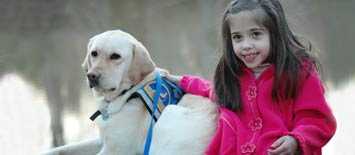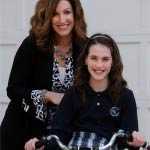Cerebral Palsy: One Parent's Story
 March 25th is Cerebral Palsy Awareness Day. About 1 in 323 children in the United States have cerebral palsy.1 Read about one family's experience with cerebral palsy and CDC's work on this condition.
March 25th is Cerebral Palsy Awareness Day. About 1 in 323 children in the United States have cerebral palsy.1 Read about one family's experience with cerebral palsy and CDC's work on this condition.
Cerebral palsy (CP) is a group of disorders that affect a person's ability to move and maintain balance and posture. CP is the most common motor disability in childhood. The symptoms of CP vary from person to person. A person with severe CP might need to use special equipment to be able to walk, or might not be able to walk at all and might need lifelong care. A person with mild CP, on the other hand, might walk a little awkwardly, but might not need any special help.
Cynthia's Story
 "Is this hopeless?" Cynthia Frisina Gray asked upon learning about her daughter's diagnosis of cerebral palsy in 2001. Cynthia knew there was a possibility that Cathryn could have problems—she was born prematurely—but she never imagined the difficulties that lay ahead. Though she seemed fine at first, after several months, Cynthia began to notice that sometimes Cathryn seemed very floppy, almost like a rag doll. Other times, she seemed to stiffen. "I knew she wasn't hitting the same growth and motor milestones like my older daughter," said Cynthia. Several doctor's appointments later, she finally received a diagnosis of cerebral palsy. Cynthia immediately went to the Internet searching for anything and everything about cerebral palsy. She felt frustrated by the limited information she could find that specifically addressed the needs of parents.
"Is this hopeless?" Cynthia Frisina Gray asked upon learning about her daughter's diagnosis of cerebral palsy in 2001. Cynthia knew there was a possibility that Cathryn could have problems—she was born prematurely—but she never imagined the difficulties that lay ahead. Though she seemed fine at first, after several months, Cynthia began to notice that sometimes Cathryn seemed very floppy, almost like a rag doll. Other times, she seemed to stiffen. "I knew she wasn't hitting the same growth and motor milestones like my older daughter," said Cynthia. Several doctor's appointments later, she finally received a diagnosis of cerebral palsy. Cynthia immediately went to the Internet searching for anything and everything about cerebral palsy. She felt frustrated by the limited information she could find that specifically addressed the needs of parents.
Cynthia expressed her frustrations to Cathryn's orthopedic surgeon, who connected Cynthia with another parent of a child with cerebral palsy: Anna Marie Champion. Cynthia and Anna Marie set out to understand how they could help educate other families about prevention and treatment. But they weren't sure where to start. They read about spina bifida, a disabling birth defect of the spine, and about the discovery that folic acid can help reduce it. "That's what we want—our 'folic acid'—something that could help prevent cerebral palsy," Cynthia said. "We found out that we can't prevent and treat cerebral palsy without understanding the root causes of it." Tracking the number of children with cerebral palsy is the first step to understanding the characteristics and finding the root causes.
"Watching Cathryn go through the pain of two major orthopedic surgeries at such a young age is hard, but we know it's necessary to help her walk," said Cynthia. Today, Cathryn is thriving but her mother knows there will be many challenges ahead. "Like all parents, I hope and dream about my daughter going to college and having a fulfilling life," said Cynthia. "I also hope that one day we know what causes cerebral palsy so that we can help others."
Tracking and Research
CDC has been studying the number of people with CP since the early 1980s. By studying the number of children diagnosed with CP over time, we can find out if the number is rising, dropping, or staying the same. We can compare the number of children with CP in different groups of people and in different areas of the country. This information can help us look for causes and risk factors of cerebral palsy, evaluate the effectiveness of prevention efforts, raise awareness of the signs and symptoms, and help families and communities plan for services. Determining whether these changes affect the rates of CP over time requires ongoing, systematic population-based tracking.
Tracking Cerebral Palsy
In 2000, CDC's National Center on Birth Defects and Developmental Disabilities established a network of collaborative programs called the Autism and Developmental Disabilities Monitoring (ADDM) Network. The ADDM Network CP prevalence reports help us understand the number and characteristics of children with CP living in several U.S. communities. Currently, there are four sites tracking CP in selected areas of Alabama, Georgia, Missouri, and Wisconsin as part of the ADDM CP Network. This ongoing, population-based approach allows ADDM to monitor changes in the prevalence of CP and characteristics of children with CP, including functional abilities and co-existing conditions, such as epilepsy. This data can help communities to plan for services and inform policy.
Researching Risk Factors or Causes
CDC's National Center on Birth Defects and Developmental Disabilities supports public health research, including studying potential causes of CP and other developmental disabilities. Past research programs in which CDC has been involved, including the Infant Development Study (IDS) and the Metropolitan Atlanta Developmental Disabilities (MADDS) Follow-up Study of Young Adults, have helped answer questions about prevention of CP and about issues related to children with CP transitioning into adulthood. Current research in which CDC is involved, including the CDC-Denmark Program, is examining factors that may make a child more likely to develop CP.
Learn more about CP tracking and research >>
Educating Parents and Healthcare Providers
The earlier a child is identified with CP, the more he or she can benefit from early intervention services which research shows may improve a child's development. The signs of CP vary greatly because there are many different types and levels of disability. The main sign that a child might have CP is a delay reaching motor or movement milestones (such as rolling over, sitting, standing, or walking). CDC's Learn the Signs. Act Early program is making an impact in the lives of families by helping parents and providers recognize the early warning signs of developmental delays and promoting early screening, evaluation, and treatment.
More Information
- Cerebral Palsy Home
- Cerebral Palsy Facts
- Learn the Signs. Act Early. Campaign
- CDC’s National Center on Birth Defects and Developmental Disabilities
- Reaching for the Stars
Reference
- Christensen D , Van Naarden Braun K , Doernberg NS , Maenner MJ , Arneson CL , Durkin MS , Benedict RE , Kirby RS , Wingate MS , Fitzgerald R , Yeargin-Allsopp M . Prevalence of cerebral palsy, co-occurring autism spectrum disorders, and motor functioning - Autism and Developmental Disabilities Monitoring Network, USA, 2008. Dev Med Child Neurol. 2014 Jan;56(1):59-65.
CDC works 24/7 saving lives and protecting people from health threats to have a more secure nation. A US federal agency, CDC helps make the healthy choice the easy choice by putting science and prevention into action. CDC works to help people live longer, healthier and more productive lives.
- Page last reviewed: January 25, 2016
- Page last updated: January 25, 2016
- Content source:
Error processing SSI file


 ShareCompartir
ShareCompartir